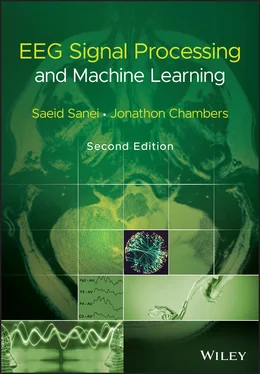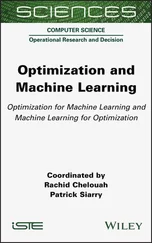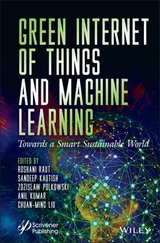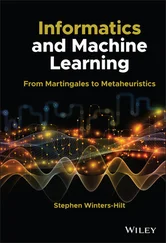Saeid Sanei - EEG Signal Processing and Machine Learning
Здесь есть возможность читать онлайн «Saeid Sanei - EEG Signal Processing and Machine Learning» — ознакомительный отрывок электронной книги совершенно бесплатно, а после прочтения отрывка купить полную версию. В некоторых случаях можно слушать аудио, скачать через торрент в формате fb2 и присутствует краткое содержание. Жанр: unrecognised, на английском языке. Описание произведения, (предисловие) а так же отзывы посетителей доступны на портале библиотеки ЛибКат.
- Название:EEG Signal Processing and Machine Learning
- Автор:
- Жанр:
- Год:неизвестен
- ISBN:нет данных
- Рейтинг книги:3 / 5. Голосов: 1
-
Избранное:Добавить в избранное
- Отзывы:
-
Ваша оценка:
- 60
- 1
- 2
- 3
- 4
- 5
EEG Signal Processing and Machine Learning: краткое содержание, описание и аннотация
Предлагаем к чтению аннотацию, описание, краткое содержание или предисловие (зависит от того, что написал сам автор книги «EEG Signal Processing and Machine Learning»). Если вы не нашли необходимую информацию о книге — напишите в комментариях, мы постараемся отыскать её.
EEG Signal Processing and Machine Learning — читать онлайн ознакомительный отрывок
Ниже представлен текст книги, разбитый по страницам. Система сохранения места последней прочитанной страницы, позволяет с удобством читать онлайн бесплатно книгу «EEG Signal Processing and Machine Learning», без необходимости каждый раз заново искать на чём Вы остановились. Поставьте закладку, и сможете в любой момент перейти на страницу, на которой закончили чтение.
Интервал:
Закладка:
47 47 Tikhonov, A. (1992). Ill‐Posed Problems in Natural Sciences. Coronet.
48 48 Roweis, S. and Ghahramani, Z. (1999). A unifying review of linear Gaussian models. Neural Computation 11: 305–345.
49 49 Dempster, A.P., Laird, N.M., and Rubin, D.B. (1977). Maximum likelihood from incomplete data via the EM algorithm. Journal of the Royal Statistical Society B 39: 1–38.
50 50 Redner, R.A. and Walker, H.F. (1984). Mixture densities, maximum likelihood and the EM algorithm. SIAM Review 26: 195–239.
51 51 Ormoneit, D. and Tresp, V. (1998). Averaging, maximum penalized likelihood and Bayesian estimation for improving Gaussian mixture probability density estimates. IEEE Transactions on Neural Networks 9 (4): 639–650.
52 52 Archambeau, C., Lee, J.A., and Verleysen, M. (2003). On convergence problems of the EM algorithm for finite Gaussian mixtures. Proceedings of the European Symposium on Artificial Neural Networks (ESANN 2003), Bruges, Belgium (23–25 April 2003), 99–106.
53 53 Hesse, C.W., Holtackers, D., and Heskes, T. (2006). On the use of mixtures of gaussians and mixtures of generalized exponentials for modelling and classification of biomedical signals. Belgian Day on Biomedical Engineering, IEEE Benelux EMBS Symposium (7–8 December).
54 54 Greenspan, H., Ruf, A., and Goldberger, J. (2006). Constrained Gaussian mixture model framework for automatic segmentation of mr brain images. IEEE Transactions on Medical Imaging 25 (9): 1233–1245.
55 55 Rio, M., Hutt, A., and Loria, B.G. (2010). Partial amplitude synchronization detection in brain signals using Bayesian Gaussian mixture models. Cinquième conférence plénière française de Neurosciences Computationnelles, “Neurocomp'10”, Lyon, France (October 2010), 109–113.
56 56 Malmivuo, J. and Plonsey, R. (1995). Bioelectromagnetism: Principles and Applications of Bioelectric and Biomagnetic Fields. Oxford University Press.
57 57 Lewis, E.R. (1964). An electronic model of the neuron based on the dynamics of potassium and sodium ion fluxes. In: Proceedings of the 1962 Ojai Symposium on Neural Theory and Modelling (eds. R.F. Reiss, H.J. Hamilton, L.D. Harmon, et al.), 427. Stanford: Stanford University Press.
58 58 Roy, G. (1972). “A simple electronic analog of the squid axon membrane,” The Neurofet. IEEE Transactions on Biomedical Engineering 19 (1): 60–63.
59 59 Eccles, J.C. (1964). The Physiology of Synapses. Berlin: Springer‐Verlag.
60 60 Harmon, L.D. (1961). Studies with artificial neurons, I: properties and functions of an artificial neuron. Kybernetik Heft 3 (Dez.):: 89–101.
61 61 Mahowald, M.A., Douglas, R.J., LeMoncheck, J.E., and Mead, C.A. (1992). An introduction to silicon neural analogs. Seminars in Neuroscience 4: 83–92.
62 62 Prange, S. (1990). Emulation of biology‐oriented neural networks. In: Proceedings of the International Conference on Parallel Processing in Neural Systems and Computers (ICNC) (ed. M. Eckmiller). Düsseldorf.
63 63 Mahowald, M.A. and Douglas, R.J. (1991). A silicon neuron. Nature 354: 515–518.
64 64 Lu, U., Roach, S.M., Song, D., and Berger, T.W. (2012). Nonlinear dynamic modelling of neuron action potential threshold during synaptically driven broadband intercellular activity. IEEE Transactions on Biomedical Engineering 59 (3): 706–716.
65 65 Azouz, R. and Gray, C.M. (1999). Cellular mechanisms contributing to response variability of cortical neurons in Vivo. Journal of Neuroscience 19 (6): 2209–2223.
66 66 Henze, D.A. and Buzsáki, G. (2001). Action potential threshold of hippocampal pyramidal cells in vivo is increased by recent spiking activity. Neuroscience 105 (1): 121–130.
67 67 Chacron, M.J., Lindner, B., and Longtin, A. (2007). Threshold fatigue and information transfer. Journal of Computational Neuroscience 23 (3): 301–311.
4 Fundamentals of EEG Signal Processing
4.1 Introduction
Electroencephalography (EEG) signals are the signatures of neural activities and generally are the integrals of active potentials which elicit from the brain with different latencies and populations around each time instant. They are captured by multiple‐electrode EEG machines either from inside the brain, over the cortex under the skull, or in the majority of applications, certain locations over the scalp. The EEG file formats are different for different recording machines but nowadays they can be easily read or converted by conventional software. The signals are normally presented in the time domain, however, many new EEG machines are capable of applying simple signal processing tools such as the Fourier transform to perform frequency analysis and equipped with some imaging tools to visualize EEG topographies (maps of the brain activities in the spatial domain).
There have been many algorithms developed so far for processing EEG signals. The operations include, but are not limited to, time‐domain analysis, frequency‐domain analysis, spatial‐domain analysis, and multiway processing. Also, several algorithms have been developed to visualize the brain activity from images reconstructed from only the EEGs namely topographs. Separation of the desired sources from the multisensor EEGs has been another research area. This can later lead to the detection of brain abnormalities such as epilepsy and the sources related to various physical and mental activities. In Chapter 17of this book we will also see that the recent works in brain–computer interfacing (BCI) [1] have been focused upon the development of advanced signal processing as well as the vast advances in cooperative networking and deep learning tools and algorithms.
Modelling of neural activities is probably more difficult than modelling the function of any other organ. However, some simple models for generating EEG signals have been proposed. Some of these models have also been extended to include generation of abnormal EEG signals.
Localization of brain signal sources is another very important field of research [2]. In order to provide a reliable algorithm for localization of the sources within the brain sufficient knowledge about both propagation of electromagnetic waves, and how the information from the measured signals can be exploited in separation and localization of the sources within the brain is required. The sources might be considered as magnetic dipoles for which the well known inverse problem has to be solved, or they can be considered as distributed current sources.
Patient monitoring and sleep monitoring require real‐time processing of (up to few days) long EEG sequences. The EEG provides important and unique information about the sleeping brain. Major brain activities during sleep can be captured using the developed algorithms such as the method of matching pursuit (MP) [3] discussed later in this chapter.
Epilepsy monitoring, detection, and prediction have also attracted many researchers. Dynamical analysis of time series together with application of blind separation of the signal sources has enabled prediction of focal epilepsies from the scalp EEGs. Conversely, application of time–frequency (TF) domain analysis for detection of the seizure in neonates has paved the way for further research in this area. An important recent contribution in the field of epilepsy is how to model the pathways between intracranial epileptiform discharges (mainly during the interictal period) and the scalp electrodes. Recent developments in this area have been made by introducing some new methods such as the multiview approach and dictionary learning [4–6] as well as deep neural network structures [7, 8] which enable capturing a considerable percentage of so‐called interictal epileptiform discharges (IEDs) from over the scalp. This technique is described in Chapters 7and 11of this book.
Читать дальшеИнтервал:
Закладка:
Похожие книги на «EEG Signal Processing and Machine Learning»
Представляем Вашему вниманию похожие книги на «EEG Signal Processing and Machine Learning» списком для выбора. Мы отобрали схожую по названию и смыслу литературу в надежде предоставить читателям больше вариантов отыскать новые, интересные, ещё непрочитанные произведения.
Обсуждение, отзывы о книге «EEG Signal Processing and Machine Learning» и просто собственные мнения читателей. Оставьте ваши комментарии, напишите, что Вы думаете о произведении, его смысле или главных героях. Укажите что конкретно понравилось, а что нет, и почему Вы так считаете.












